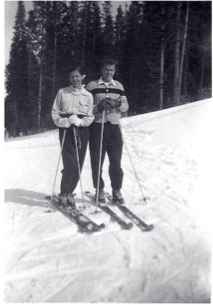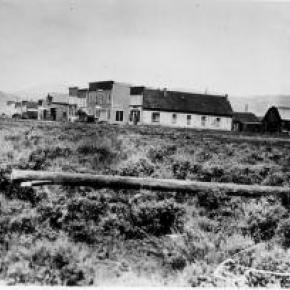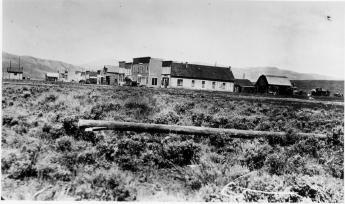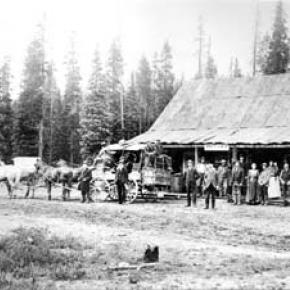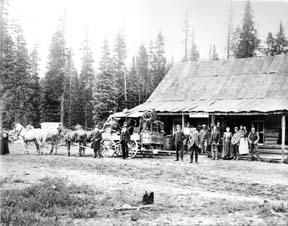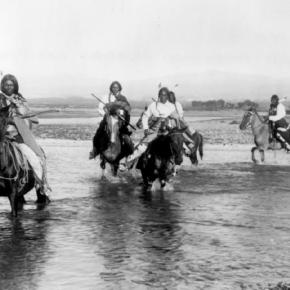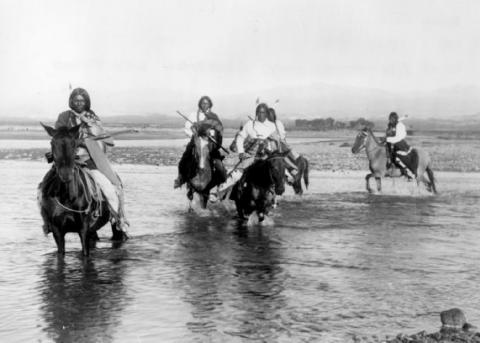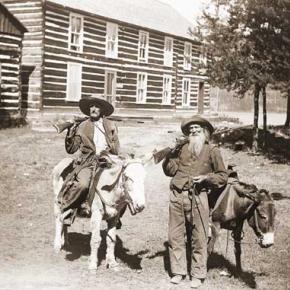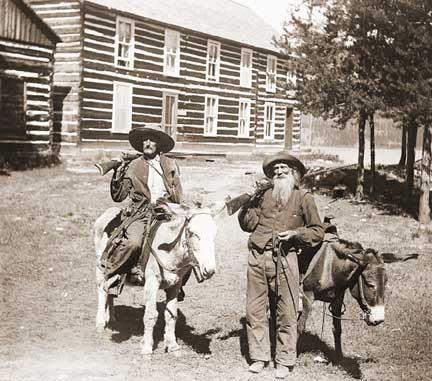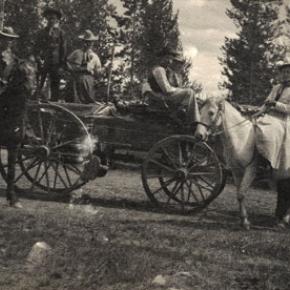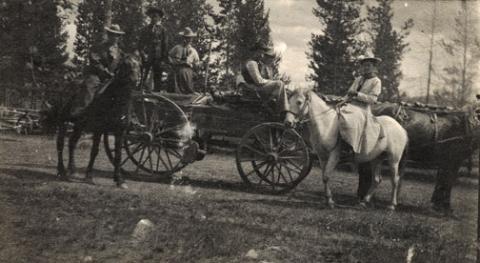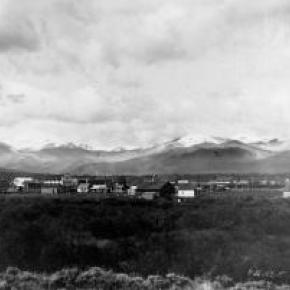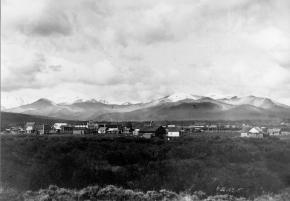A shooting in the Old West I know was not much like the shootings on television today. There was no glorification of the bad man. Killings were usually like the fatal shooting of Indian Tom on that 6th of September, 1906, in old Arrowhead (or Arrow). Nobody called anybody out. Nobody told anybody to draw or asked him if he was wearing a gun. It wasn’t a fight. It was a killing.
1906 Arrow had six saloons, a grocery store, one small hotel and a livery stable. But two thousand people picked up their mail there. The woods were full of tie-hacks: the three sawmills hired may lumberjacks and teamsters, most of them Swedes, who seemed to make the best lumbermen. I had arrived in Arrow the 18th of April that year to work as a teamster for my brother Virgil, who had been operating a sawmill there for about a year. I was just sixteen.
My brother Dick, the tallest Lininger, had been Virgil’s foreman. Virgil had also bought the only hotel in Arrow. My mother, two sisters and my little brother Gilbert and I came from our farm in Osawatomie, Kansas, so that my mother could run the hotel. My brother Wesley came at that time too: he planned to buy a lot and build a café. Whole families often followed the first member who had come to these early Colorado towns. I soon discovered that driving logging horses needed a lot more technique than driving a small farm team, but Virgil was patient, and I soon received a raise to $2.75 a day as top teamster.
The town was a wide open as it could get. My first introduction to the violence was the day my brother Dick fired three drunken lumberjacks. They drew their pay and went to Graham’s saloon to get drunker. As dick passed the saloon later, one of the men grabbed a quart whiskey bottle, and ran out and struck Dick behind the ear, knocking him cold. The three then proceeded to kick him around. Dick’s roommate Charley came to my brother’s rescue. When Dick came to, he started for the hotel. Charley guessed what he was after and beat him to the six-shooter. “I’ll make sure you can taken them one at a time” Charley promised him. I came along just as my brother knocked the pick from the pick handle. Something was up! In less time than it takes to tell it, Dick had three drunks out cold.
Mother patched Dick up. I think this was her introduction, too. A man couldn’t stay boss long if stayed whipped. Every other Sunday was a holiday for me although I always saw to it that I put in enough overtime to bring my monthly paycheck to $75. That September Sunday I was dressed in my holiday garb – tan peg-top dress corduroys, light blue wool shirt, Western hat, and high-laces boots as befitting a teamster who drove four or six horses hauling logs from timber country to the saw mill. When I drove six horses, I rode one of the wheel-team horses and held the lines over four. If I drove four horses, I rode the wagon and sat on a sack of hay.
About noon, I stopped in front of the MacDonald saloon to talk to Ed MacDonald, one of the few saloon men my mother didn’t disapprove of. After all, Ed had come to Colorado as a TB and couldn’t do heavy work; filling glasses over a bar was about the only light work in those old mountain towns. Later Ed owned the famous MacDonald Ranch on the South Fork of the Grand Rover – now Colorado River- and managed boats on Monarch Lake just above his ranch. He always served great dinners and good food. While Ed and I were talking, Indian Tom rode up. He was a flashy cowboy of the old school, a very good looking man with predominantly Indian features although he was only half Cherokee. When riding, Tom always wore leather chaps, spurs, and a big Stetson. As wagon foreman for Orman and Crook, contractors for building the Moffat Road, he was a very important figure, for he had charge of all their wagons and teamsters. The greeting between Ed and Tom was cordial.
Everyone liked Indian Tom. When Tom learned I was a teamster for my brother Virgil, Tom showed a much keener interest and invited me in to MacDonald’s for a drink. Ed rescued me. “Oh the kids doesn’t drink; but he might like a cigar”. As they ordered drinks, I puffed away in my best imitation of a Kentucky colonel; however I soon excused myself, saying that I had to target my 30-30 rifle for the upcoming deer season. I puffed until I was out of sight. The corn silk I had scorched behind the barn paid off. I didn’t disgrace myself, nor had I broken my pledge to my mother not to gamble, use profanity, drink, or perform any act inconsistent with the conduct of a gentleman. I took my rifle northwest of Arrow to Fawn Creek.
It was a beautiful fall day. The aspen were just beginning to turn. Fawn Creek Gulch had been burned over many years before by the Indians who hoped in this way to discourage settlers, and the aspen were all young, straight and shimmering in the way that has never ceased to delight me. The fire thirty years before had made the gulch an excellent place for deer hunting because the new growth gave the deer some inviting protection, but the terrain was open enough for a hunter to locate his game. I figured I’d have to shoot from at least 200 yards, so I planned to target for that distance. I tacked a piece of cardboard I’d cut from my brother’s Stetson hat box (he never took off his Stetson off anyway) to a tree and stepped off the 200 yards. That 6-inch target looked pretty small but after each three shots, I’d examine the target. Finally satisfied, I took a long walk looking for deer sign, tracks, or droppings. I found good sign but no droppings. About feeding time for the horses, I went back to the barn in town to feed the four, Cap, the big bay, Bird, the glossy black (those were my two wheel horses- t e ones next to the wheel); Kate, the little lead horse; and Bud, her mate.
Virgil had bought Kate, a grey mare weighing about 1400 pounds, at a very reasonable price from the Adams Express Company because she had run away at every opportunity and had destroyed several wagons. He couldn’t run away now pulling Cap, Bird and a load of lumber with her, but her high spirits made her an excellent leader. The heavier team, always used as the wheel team, weighed about 1700 pounds each. I was very proud of this unusually fine team. Virgil had trained Cap and Bird so that after they were harnessed in the barn, they could be turned loose to go to the watering trough, drink long and thirstily, then walk out to the wagon, back into position by the tongue, and stand ready to have the breast straps snapped in place and the tongue attached. When tourists trains stopped and hundreds of passengers stood around the eating places looking the town over, I’d drive slowly by, and then stop to rest the team a minute, to give the dudes a chance to see a good, four-horse team. Then with a single “Yup!” I’d pull all the lines tight, and they’d start as one horse while the tourists explained and pointed.
That Sunday after I put a gallon of oats in their food box and shook some hay into their manger, I left the barn and started up the steps alongside the depot. It was still light; the sky hadn’t even begun to color. Time to head home for supper. I’d have to be up, hitched and pulled by seven the next morning. We’d probably have roast beef or roast chicken with noodles, since it was Sunday. Mother would be cooking on the big wood-burning stove at the hotel, and my sisters would be taking the heaping platters to the tables where everyone would pass them around. Probably there would be hot biscuits.
Suddenly a shot cracked just above me and across the street. I knew instantly it had come from the Wolf Saloon ahead. It wasn’t common to hear shots in those days. You hear more in a 20-minute Western on TV than you heard in a couple of years unless a few boys rode into town on a Saturday night to shoot up the air. I broke into a run and could see a man lying on the board walk in front of the saloon. As I got to him, one of the ladies I wasn’t permitted to mention came out and fell to her knees beside him. Raising the man’s head, she tried to pour whiskey down his throat. With a queer, paralyzed feeling, I realized it was Indian Tom. I reached for his wrist. His hand was warm as life, but there was no pulse. Several men ran our. “Ragland got him!” one of them shouted.
We carried Tom’s body into MacDonald’s and laid him on a roulette table that was in the back room for repair. Somebody went to wire for the sheriff at Hot Sulphur Springs. Word soon reached Orman and Crook’s, and the Indian’s many friends began to jam into Arrow. Indian Tom and Ragland had evidently had words during the afternoon and had quarrels once more before at a rodeo. The women from the saloon said that when Indian Tom left after the quarrel, Ragland had stationed himself, gun in hand, inside the saloon door. Everyone agreed that Ragland knew he wouldn’t have had a chance in a fair fight with Tom. The moment they heard Tom’s spurs outside , Ragland pushed the door slightly open and shot point blank through the aperture along the hinge. The he ran out the back door. We searched the town inside and out for Ragland. The sheriff joined is in the search late that night, but we found no trace of him. Just after midnight a wire came for the sheriff. Ragland had turned himself in at Hot Sulphur. We learned later he had run to a ranch down below, borrowed a horse and ridden for his life. A coroner’s jury was called.
My brother Virgil, named foreman, took a firm stand. The only verdict he intended to take out of that room was murder, and, after only a few hours, that was their verdict. After three days, Ragland was released on $3,000 bond posted by his father, but you may be sure he didn’t show himself around Arrow. His attorney, John A. DeWeese, got a change of venue from Grand County to Jefferson County at Golden, claiming an article in the Middle Park Times of September 7, 1906, reporting the verdict of the coroner’s jury, made it impossible for Ragland to get a fair trial in Hot Sulphur. The article said in part: Four witnesses for the prosecution, and seven for the Defendant were examined, making eleven in all. The testimony of the witnesses on both sides failed to show that the shooting was justifiable. According to the testimony, the fatal shot was fired when Reynolds (Tom) had his revolver in his scabbard and when he did not even see Ragland who was standing opposite the cut-off. (As told to Donna Geyer by A.W. Lininger)








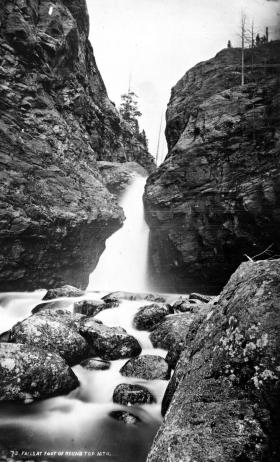
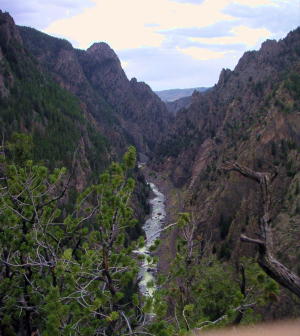
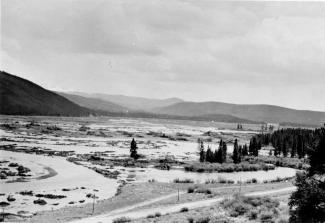



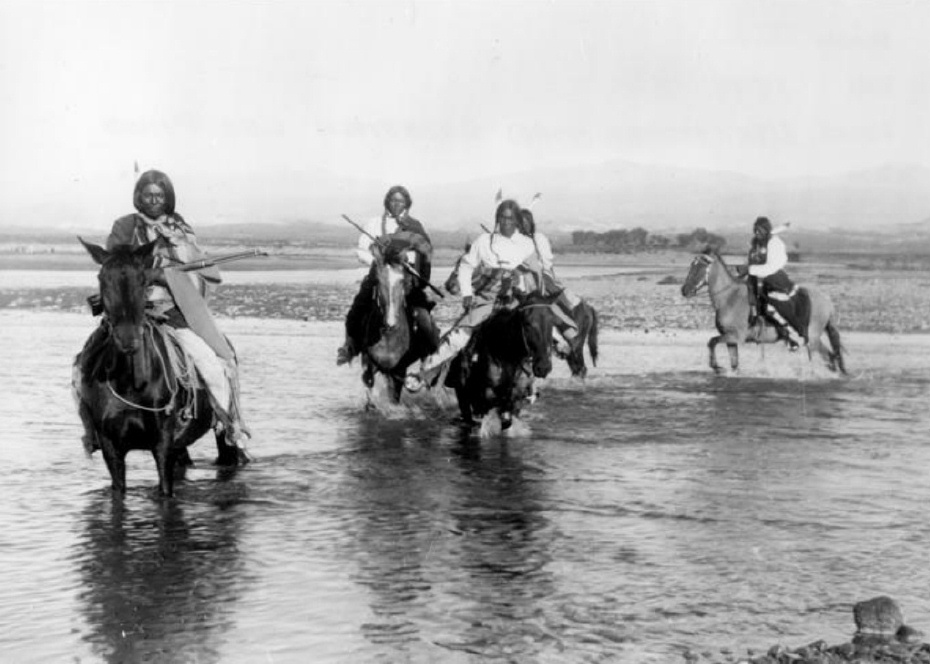
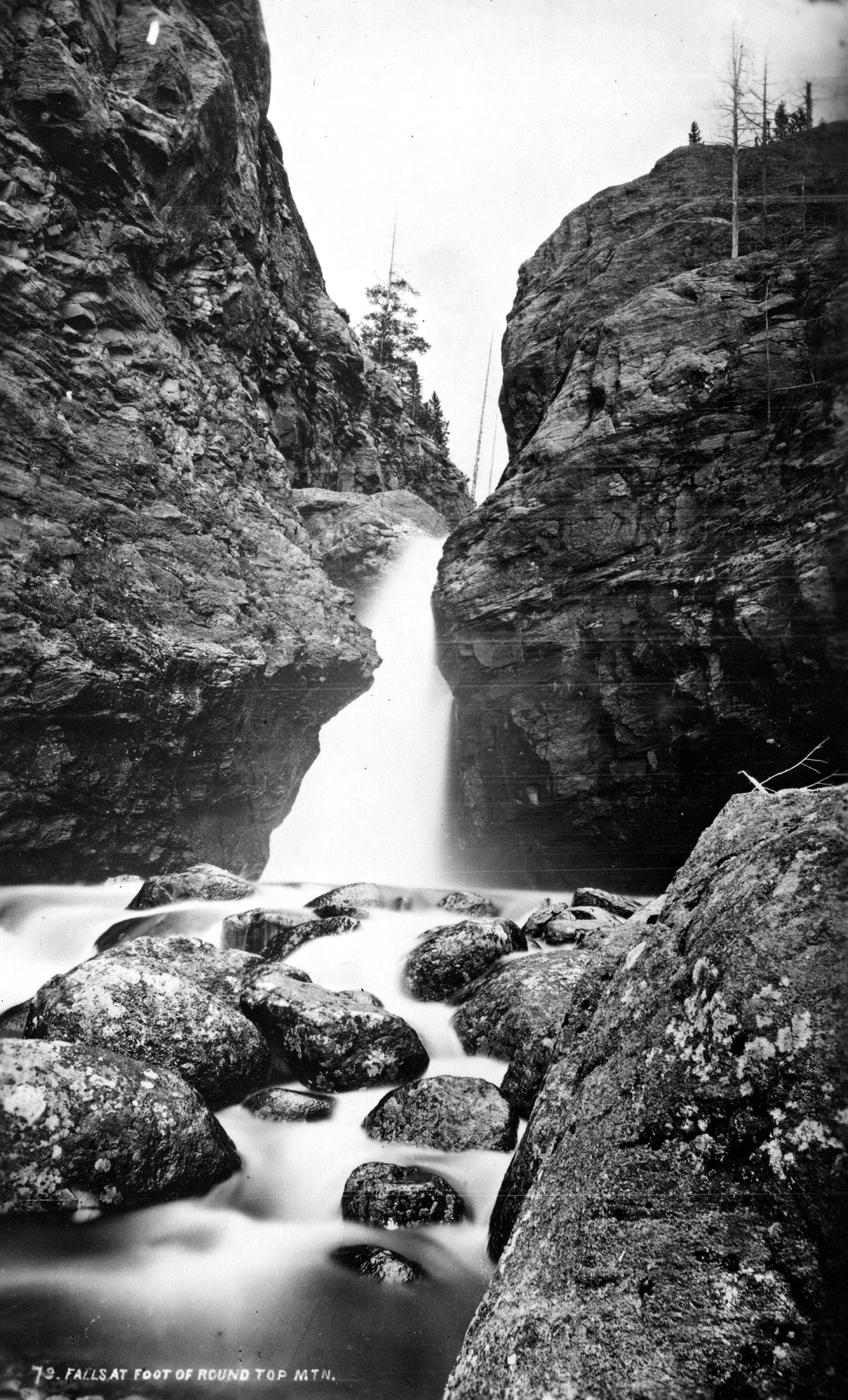
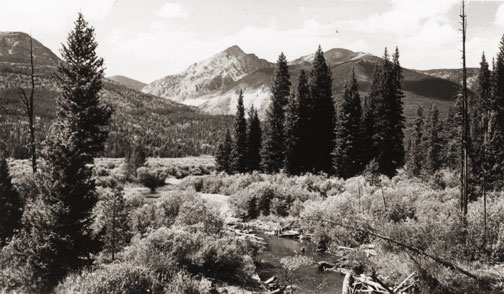
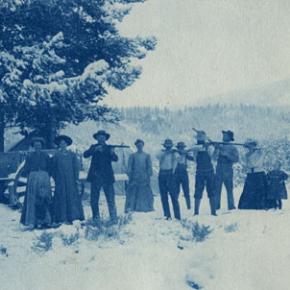
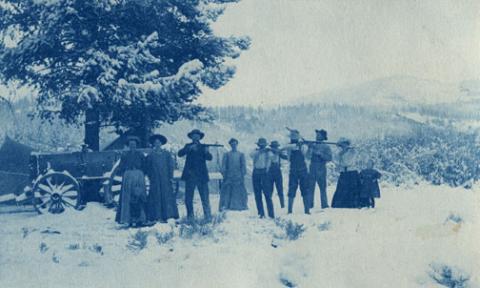
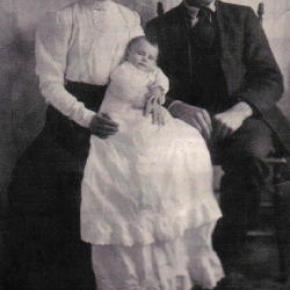
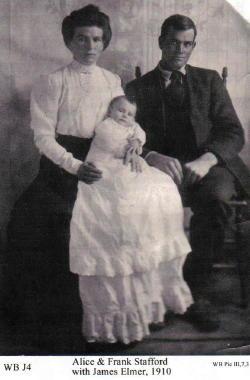
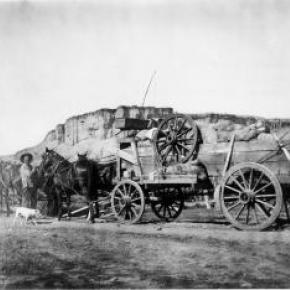
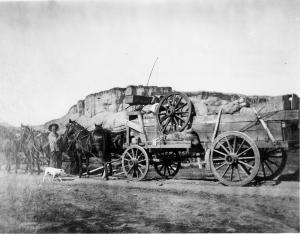
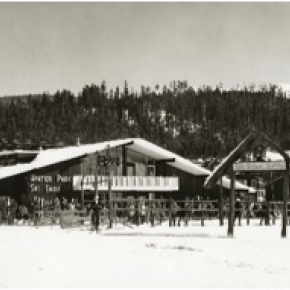
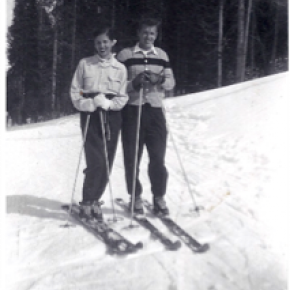
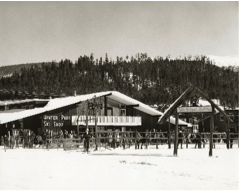 ,
, 